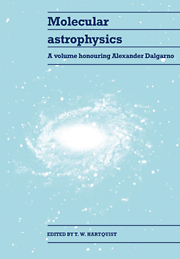Book contents
- Frontmatter
- Contents
- Dedication
- Preface
- Part I Molecular clouds and the distribution of molecules in the Milky Way and other galaxies
- Part II Diffuse molecular clouds
- Part III Quiescent dense clouds
- Part IV Studies of molecular processes
- Part V Atomic species in dense clouds
- 14 Observations of atomic species in dense clouds
- 15 Ultraviolet radiation in molecular clouds
- 16 Cosmic ray induced photodissociation and photoionization of interstellar molecules
- 17 Chemistry in the molecular cloud Barnard 5
- 18 Molecular cloud structure, motions, and evolution
- Part VI H2 in regions of massive star formation
- Part VII Molecules near stars and in stellar ejecta
- Part VIII Moderately ionized gas and chemistry at large redshifts
- Index
18 - Molecular cloud structure, motions, and evolution
Published online by Cambridge University Press: 10 December 2009
- Frontmatter
- Contents
- Dedication
- Preface
- Part I Molecular clouds and the distribution of molecules in the Milky Way and other galaxies
- Part II Diffuse molecular clouds
- Part III Quiescent dense clouds
- Part IV Studies of molecular processes
- Part V Atomic species in dense clouds
- 14 Observations of atomic species in dense clouds
- 15 Ultraviolet radiation in molecular clouds
- 16 Cosmic ray induced photodissociation and photoionization of interstellar molecules
- 17 Chemistry in the molecular cloud Barnard 5
- 18 Molecular cloud structure, motions, and evolution
- Part VI H2 in regions of massive star formation
- Part VII Molecules near stars and in stellar ejecta
- Part VIII Moderately ionized gas and chemistry at large redshifts
- Index
Summary
Introduction
This chapter describes some aspects of the structure, motions, energies, and evolution of molecular clouds, from the viewpoint of observations and simple models. The emphasis is on observations of nearby clouds, and on physical, rather than chemical properties. The approach is partly pedagogical and partly a summary of recent results. Recent reviews on related subjects are those of Blitz (1987; diffuse molecular clouds), Scalo (1987; turbulence), Mouschovias (1987; magnetic effects), Shu, Adams and Lizano (1987; cloud physics and star formation), and Larson (1988; large-scale aspects of cloud and star formation). A review with a similar viewpoint to this one, but with older information, appears in Myers (1987).
We consider a molecular cloud to be a collection of interstellar gas and dust, whose gas has a substantial molecular component, and whose mean density inside an observationally definable boundary exceeds that outside the boundary. In this chapter we do not discuss galaxies, or molecular clouds in galaxies other than the Milky Way. Further information on these subjects is in Chapter 2.
The main constituents of molecular clouds, other than molecules, are stars, the ‘cores’ or condensations that form stars, dust grains, ions, and atoms. In this chapter we focus on the role of stars and cores.
The material in this chapter is organized into discussions of cloud structure and kinematics (Section 18.2), cloud energetics (Section 18.3), and time scales and evolution (Section 18.4).
- Type
- Chapter
- Information
- Molecular AstrophysicsA Volume Honouring Alexander Dalgarno, pp. 328 - 342Publisher: Cambridge University PressPrint publication year: 1990
- 8
- Cited by

